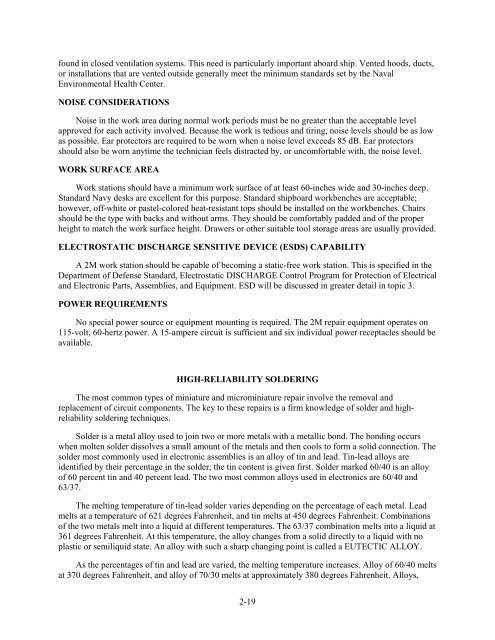Navy Electricity and Electronics Training Series - Historic Naval ...
Navy Electricity and Electronics Training Series - Historic Naval ...
Navy Electricity and Electronics Training Series - Historic Naval ...
You also want an ePaper? Increase the reach of your titles
YUMPU automatically turns print PDFs into web optimized ePapers that Google loves.
found in closed ventilation systems. This need is particularly important aboard ship. Vented hoods, ducts,or installations that are vented outside generally meet the minimum st<strong>and</strong>ards set by the <strong>Naval</strong>Environmental Health Center.NOISE CONSIDERATIONSNoise in the work area during normal work periods must be no greater than the acceptable levelapproved for each activity involved. Because the work is tedious <strong>and</strong> tiring, noise levels should be as lowas possible. Ear protectors are required to be worn when a noise level exceeds 85 dB. Ear protectorsshould also be worn anytime the technician feels distracted by, or uncomfortable with, the noise level.WORK SURFACE AREAWork stations should have a minimum work surface of at least 60-inches wide <strong>and</strong> 30-inches deep.St<strong>and</strong>ard <strong>Navy</strong> desks are excellent for this purpose. St<strong>and</strong>ard shipboard workbenches are acceptable;however, off-white or pastel-colored heat-resistant tops should be installed on the workbenches. Chairsshould be the type with backs <strong>and</strong> without arms. They should be comfortably padded <strong>and</strong> of the properheight to match the work surface height. Drawers or other suitable tool storage areas are usually provided.ELECTROSTATIC DISCHARGE SENSITIVE DEVICE (ESDS) CAPABILITYA 2M work station should be capable of becoming a static-free work station. This is specified in theDepartment of Defense St<strong>and</strong>ard, Electrostatic DISCHARGE Control Program for Protection of Electrical<strong>and</strong> Electronic Parts, Assemblies, <strong>and</strong> Equipment. ESD will be discussed in greater detail in topic 3.POWER REQUIREMENTSNo special power source or equipment mounting is required. The 2M repair equipment operates on115-volt, 60-hertz power. A 15-ampere circuit is sufficient <strong>and</strong> six individual power receptacles should beavailable.HIGH-RELIABILITY SOLDERINGThe most common types of miniature <strong>and</strong> microminiature repair involve the removal <strong>and</strong>replacement of circuit components. The key to these repairs is a firm knowledge of solder <strong>and</strong> highreliabilitysoldering techniques.Solder is a metal alloy used to join two or more metals with a metallic bond. The bonding occurswhen molten solder dissolves a small amount of the metals <strong>and</strong> then cools to form a solid connection. Thesolder most commonly used in electronic assemblies is an alloy of tin <strong>and</strong> lead. Tin-lead alloys areidentified by their percentage in the solder; the tin content is given first. Solder marked 60/40 is an alloyof 60 percent tin <strong>and</strong> 40 percent lead. The two most common alloys used in electronics are 60/40 <strong>and</strong>63/37.The melting temperature of tin-lead solder varies depending on the percentage of each metal. Leadmelts at a temperature of 621 degrees Fahrenheit, <strong>and</strong> tin melts at 450 degrees Fahrenheit. Combinationsof the two metals melt into a liquid at different temperatures. The 63/37 combination melts into a liquid at361 degrees Fahrenheit. At this temperature, the alloy changes from a solid directly to a liquid with noplastic or semiliquid state. An alloy with such a sharp changing point is called a EUTECTIC ALLOY.As the percentages of tin <strong>and</strong> lead are varied, the melting temperature increases. Alloy of 60/40 meltsat 370 degrees Fahrenheit, <strong>and</strong> alloy of 70/30 melts at approximately 380 degrees Fahrenheit. Alloys,2-19

















